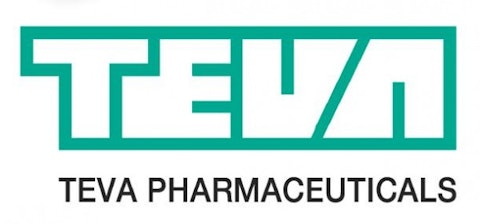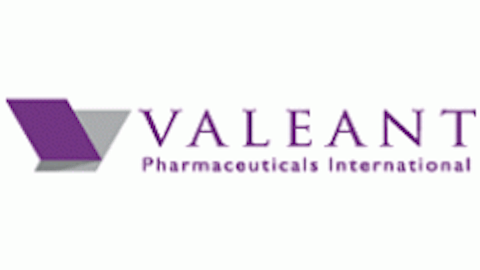Generic producers are often regarded as the safer players within BioPharma. They take existing drugs that have fallen off patents, tweak them a bit, and release a product into the market. R&D expenses are kept low, and business is relatively predictable.
Similarly, medical device companies have lower risk profiles by virtue of their more predictable operating model. However, they both have experienced their own problems and are not resting on their laurels. To create value, they need to innovate and grow returns above the weighted average cost of capital. Below, I present my take on several companies within these two markets.
What Teva can gain from entering new markets
Teva Pharmaceutical Industries Ltd (ADR) (NYSE:TEVA) has been aggressively trying to shift away from its multiple sclerosis Copaxone, which makes up the bulk of its revenue. Its new $90 million plant in India recently began construction and is expected to produce consumer health-related products, which include inhalers, syrups, and other similar products. This new plant will operate under a local brand name of “Vicks” and should be completed by 2015. While relatively minor, it is a step in the right direction. Larger steps include the focus on executing a “pearl of strings acquisition” strategy akin to what the new CEO implemented over at Bristol-Myers.
The world’s largest generic producer should explore takeover activity in the medical device market to limit downside and shift towards greater predictability. Teva Pharmaceutical Industries Ltd (ADR) (NYSE:TEVA) should look towards adopting a more predictable business model by expanding into the medical device market. Failing to receive FDA approval for a drug versus a medical device product may mean the difference between having to start from scratch versus simply having to just follow-up on what works.
The medical device market also involves much less “shooting in the dark” than, say, the pharmaceutical market. And unlike many emerging firms, Teva Pharmaceutical Industries Ltd (ADR) (NYSE:TEVA)’s medical device division (“Teva Medical”) fortunately comes equipped with strong liquidity from a recognizable parent company. Why not use some of that $2.9 billion in cash to add obvious free cash flow generators? This would certainly take more of the attention off of patent cliffs by giving investors some “breathing room.”
Reasons to buy Teva irrespective of business shift
If nothing else, Teva has a lot to offer to defensive investors. It was recently named one of the top 10 companies in the Dividend Channel’s International S.A.F.E. 10 because of its current 2.90% dividend yield and a track-record of strong growth over the past five years. The S.A.F.E. status can only be achieved if all of the four marks –S for “solid return,” A for “accelerating amount,” F for “flawless 5-year track-record,” and E for “enduring”– come above average.
Ultimately, I remain very optimistic about Teva. The stock trades at only 7.3 times forward earnings and is more than 60% less volatile than the broader market. Free cash flow yield is strong at 7.3%, and the firm is expected to show 8.9% annual EPS growth over the next five years, which is relatively predictable. Combined with the dividend yield, Teva Pharmaceutical Industries Ltd (ADR) (NYSE:TEVA) is a winning stock for defensive investors.
Will Mylan Inc. (NASDAQ:MYL) continue to soar?
Mylan Inc. (NASDAQ:MYL) is yet another company that has had difficulties but managed to correct them. Operational scaling — like expanding internationally by opening a new arm in Ireland — has strengthened upside prospects. The result is that the generic manufacturer has been on a relentless 50%+ rise to its 52-week high. Thus, it too provides a perfect case study for Teva Pharmaceutical Industries Ltd (ADR) (NYSE:TEVA) turnaround executives.
The company has, however, run into its share of problems. The company is now facing a lawsuit from Santarus, which filed a patent infringement lawsuit for its Fenoglide tablets product. The reason for this lawsuit was the ANDA Mylan signed to create generic versions of Santarus’ product, but Fenoglide is still under a patent protection until 2024.
A federal court also recently dismissed Mylan Inc. (NASDAQ:MYL)’s complaint against a decision to withhold the company’s generic version of Diovan. However, all of this is more than offset by FDA approvals for the generic versions of Maxalt to treat migraine headaches and for an ANDA for a partner’s contraception product. At 9.5 times forward earnings and 10.3% EPS growth forecasts, reward outweighs risk.
Hedge with Johnson & Johnson
Johnson & Johnson (NYSE:JNJ) ultimately remains one of the safest healthcare investments. With diversification in consumer goods and a 3.10% dividend yield, its investment returns are more predictable than Mylan’s or Teva Pharmaceutical Industries Ltd (ADR) (NYSE:TEVA)‘s. It has risen 42% from its 52-week low and is more or less reasonably priced at 14.6 times forward earnings.
Assuming Johnson & Johnson (NYSE:JNJ) grows EPS by 6.3% over the next five years, 2018 EPS will come out to $7.40, which, at a multiple of 14x, translates to a future stock value of $103.60. When you factor in dividend distributions, the net result is an average annual return of 7.6%. While a 7.6% return may not be for high-growth investors, it is a nice stable hedge against uncertainty at Teva and Mylan.
Conclusion
Companies can and do run into mistakes. From failing to take the pressure off of patent cliffs to competitor lawsuits, Teva Pharmaceutical Industries Ltd (ADR) (NYSE:TEVA) and Mylan have erred. However, both have started to focus on growth and risk-mitigating product opportunities. The two trade below historical multiples even though their past mistakes are isolated and have no impact on the future. I, therefore, believe a market correction will be in order and, thus, encourage buying shares sooner rather than later.
The article Undervalued Teva Must Enter New Markets originally appeared on Fool.com and is written by David Gould.
David Gould has no position in any stocks mentioned. The Motley Fool recommends Johnson & Johnson. The Motley Fool owns shares of Johnson & Johnson. David is a member of The Motley Fool Blog Network — entries represent the personal opinion of the blogger and are not formally edited.
Copyright © 1995 – 2013 The Motley Fool, LLC. All rights reserved. The Motley Fool has a disclosure policy.





